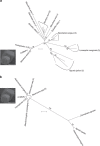Population genomics supports baculoviruses as vectors of horizontal transfer of insect transposons
- PMID: 24556639
- PMCID: PMC3948050
- DOI: 10.1038/ncomms4348
Population genomics supports baculoviruses as vectors of horizontal transfer of insect transposons
Abstract
Horizontal transfer (HT) of DNA is an important factor shaping eukaryote evolution. Although several hundreds of eukaryote-to-eukaryote HTs of transposable elements (TEs) have been reported, the vectors underlying these transfers remain elusive. Here, we show that multiple copies of two TEs from the cabbage looper (Trichoplusia ni) transposed in vivo into genomes of the baculovirus Autographa californica multiple nucleopolyhedrovirus (AcMNPV) during caterpillar infection. We further demonstrate that both TEs underwent recent HT between several sympatric moth species (T. ni, Manduca sexta, Helicoverpa spp.) showing different degrees of susceptibility to AcMNPV. Based on two independent population genomics data sets (reaching a total coverage >330,000X), we report a frequency of one moth TE in ~8,500 AcMNPV genomes. Together, our results provide strong support for the role of viruses as vectors of TE HT between animals, and they call for a systematic evaluation of the frequency and impact of virus-mediated HT on the evolution of host genomes.
Figures


Similar articles
-
Continuous Influx of Genetic Material from Host to Virus Populations.PLoS Genet. 2016 Feb 1;12(2):e1005838. doi: 10.1371/journal.pgen.1005838. eCollection 2016 Feb. PLoS Genet. 2016. PMID: 26829124 Free PMC article.
-
Assessing the Impact of a Viral Infection on the Expression of Transposable Elements in the Cabbage Looper Moth (Trichoplusia ni).Genome Biol Evol. 2021 Nov 5;13(11):evab231. doi: 10.1093/gbe/evab231. Genome Biol Evol. 2021. PMID: 34613390 Free PMC article.
-
Monitoring Insect Transposable Elements in Large Double-Stranded DNA Viruses Reveals Host-to-Virus and Virus-to-Virus Transposition.Mol Biol Evol. 2021 Aug 23;38(9):3512-3530. doi: 10.1093/molbev/msab198. Mol Biol Evol. 2021. PMID: 34191026 Free PMC article.
-
Viruses as vectors of horizontal transfer of genetic material in eukaryotes.Curr Opin Virol. 2017 Aug;25:16-22. doi: 10.1016/j.coviro.2017.06.005. Epub 2017 Jun 30. Curr Opin Virol. 2017. PMID: 28672159 Review.
-
Transposable Elements and the Evolution of Insects.Annu Rev Entomol. 2021 Jan 7;66:355-372. doi: 10.1146/annurev-ento-070720-074650. Epub 2020 Sep 15. Annu Rev Entomol. 2021. PMID: 32931312 Review.
Cited by
-
DNA transposons have colonized the genome of the giant virus Pandoravirus salinus.BMC Biol. 2015 Jun 12;13:38. doi: 10.1186/s12915-015-0145-1. BMC Biol. 2015. PMID: 26067596 Free PMC article.
-
Horizontal Gene Transfer Contributes to the Evolution of Arthropod Herbivory.Genome Biol Evol. 2016 Jun 27;8(6):1785-801. doi: 10.1093/gbe/evw119. Genome Biol Evol. 2016. PMID: 27307274 Free PMC article.
-
Transposon-Mediated Horizontal Transfer of the Host-Specific Virulence Protein ToxA between Three Fungal Wheat Pathogens.mBio. 2019 Sep 10;10(5):e01515-19. doi: 10.1128/mBio.01515-19. mBio. 2019. PMID: 31506307 Free PMC article.
-
Mosaic genome evolution and phylogenetics of Chrysodeixis includens nucleopolyhedrovirus (ChinNPV) and virulence of seven new isolates from the Brazilian states of Minas Gerais and Mato Grosso.Arch Virol. 2021 Jan;166(1):125-138. doi: 10.1007/s00705-020-04858-2. Epub 2020 Oct 27. Arch Virol. 2021. PMID: 33111162
-
Extensive exchange of transposable elements in the Drosophila pseudoobscura group.Mob DNA. 2018 Jun 19;9:20. doi: 10.1186/s13100-018-0123-6. eCollection 2018. Mob DNA. 2018. PMID: 29946370 Free PMC article.
References
-
- Ochman H., Lawrence J. G. & Groisman E. A. Lateral gene transfer and the nature of bacterial innovation. Nature 405, 299–304 (2000). - PubMed
-
- Keeling P. J. & Palmer J. D. Horizontal gene transfer in eukaryotic evolution. Nat. Rev. Genet. 9, 605–618 (2008). - PubMed
-
- Syvanen M. Evolutionary implications of horizontal gene transfer. Annu. Rev. Genet. 46, 341–358 (2012). - PubMed
-
- Frost L. S., Leplae R., Summers A. O. & Toussaint A. Mobile genetic elements: the agents of open source evolution. Nat. Rev. Microbiol. 3, 722–732 (2005). - PubMed
Publication types
MeSH terms
Substances
LinkOut - more resources
Full Text Sources
Other Literature Sources
Miscellaneous

